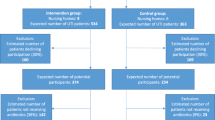Abstract
Objective: To elucidate the steps in the management of urinary tract infections (UTIs) in elderly nursing home residents, in order to derive data which would assist in an economic evaluation of such infections.
Method: Maximum variation sampling was used to recruit General Practitioners (GPs) and nurses (who worked in nursing homes), into the study. Using semi-structured interviews, a topic guide was used to explore diagnosis, treatment and the role of GPs and nurses in the management of UTIs in nursing home residents. Thematic analysis was employed to identify the main themes.
Main outcome measures: A comprehensive description of the management of UTIs in nursing home residents that will be used in a future economic evaluation of the costs of this prevalent infection in this setting.
Results: Ten GPs and nurses respectively took part in the interviews. Three overarching themes emerged from the interviews: information, processes and decision-making. Health care professionals described the key symptoms for diagnosis (information), testing procedures to confirm the presence of an infection (processes); many variations in management pathways were described. The nurse was central to decision-making in treatment i.e. prescribing of an antibiotic. Most GPs reported that they accepted the nursing staff’s assessment of the resident and seldom visited a patient in a nursing home for a UTI.
Conclusions: The management approach to UTIs varied greatly and was a more complex process than anticipated. Identification of the component steps will be used to perform an economic evaluation of UTIs in nursing homes.
Similar content being viewed by others
References
RB. Breitenbucher (1990) ArticleTitleUTI: managing the most common nursing home infection Geriatrics 45 68–75
LE. Nicolle (2001) Urinary tract infections in long-term-care facilities Infect Control Hosp Epidemiol 22 167–75
MT. Beier (1999) ArticleTitleManagement of urinary tract infections in the nursing home elderly: a proposed algorithmic approach Int J Antimicrob Agents 11 275–84 Occurrence Handle10.1016/S0924-8579(99)00030-8 Occurrence Handle10394983
LE. Nicolle (1999) ArticleTitleUrinary infections in the elderly: symptomatic or asymptomatic? Int J Antimicrob Agents 11 265–8 Occurrence Handle10.1016/S0924-8579(99)00028-X Occurrence Handle10394981
S. Stone (1999) ArticleTitleSoil, seed and climate: Developing a strategy for prevention and management of infections in UK nursing homes J Hosp Infect 43 IssueIDSuppl S29–S38 Occurrence Handle10.1016/S0195-6701(99)90063-4 Occurrence Handle10658756
LE. Nicolle (2002) ArticleTitleResistant pathogens in urinary tract infections J Am Geriatr Soc 50 S230–5 Occurrence Handle10.1046/j.1532-5415.50.7s.3.x Occurrence Handle12121518
CA Wood E. Abrutyn (1996) ArticleTitleOptimal treatment of urinary tract infections in elderly patients Drugs Aging 9 352–62 Occurrence Handle8922562
J Colling M McCreedy T. Owen (1994) ArticleTitleUrinary tract infection rates among incontinent nursing home and community dwelling elderly Urol Nursing 14 117–9
JD. McCue (1993) ArticleTitleUrinary tract infections in the elderly Pharmacotherapy 13 S51–3
C Dawson H. Whitfield (1996) ArticleTitleABC of urology. Urinary incontinence and urinary infection BMJ 312 961–4 Occurrence Handle8616315
JP Patton DB Nash E. Abrutyn (1991) ArticleTitleUrinary tract infections: economic considerations Med Clin North America 75 495–513
CC Butler S Rollnick R Pill F Maggs-Rapport N. Stott (1998) ArticleTitleUnderstanding the culture of prescribing: qualitative study of general practitioners’ and patients’ perceptions of antibiotics for sore throats BMJ 317 637–42 Occurrence Handle9727992
Eastern Health and Social Services Board. (2000). Northern Ireland Registration and inspection unit-list of nursing homes, Belfast
McNulty C, Freeman E, Nichols T, Kalima P. (2003). Laboratory diagnosis of urinary symptoms in primary care–a qualitative study Commun. Dis Public Health 6: 44–50
Z Zaman A Borremans J Verhaegen L Verbist N. Blanckaert (1998) ArticleTitleDisappointing dip-stick screening for urinary tract infection in hospital inpatients J Clin Pathol 51 471–2 Occurrence Handle9771448
S. Brown (2002) ArticleTitleSystematic review of nursing management of urinary tract infections in the cognitively impaired elderly client in residential care: Is there a hole in holistic care? Int J Nursing Practice 8 2–7 Occurrence Handle10.1046/j.1440-172x.2002.00324.x
JW Warren FB Palumbo L Fitterman SM. Speedie (1991) ArticleTitleIncidence and characteristics of antibiotic use in aged nursing home patients J Am Geriatr Soc 39 963–72 Occurrence Handle1918783
P Takahashi N Trang D Chutka J. Evans (2002) ArticleTitleAntibiotic prescribing and outcomes following treatment of symptomatic urinarytract infections in older women J Am Med Dir Assoc 3 352–3 Occurrence Handle10.1016/S1525-8610(04)70525-3 Occurrence Handle12807602
I Nazareth M. King (1992) ArticleTitleDecision making by general practitioners in diagnosis and management of lower urinary tract symptoms in women BMJ 306 1103–6
M Vromen AJ Ven Particlevan der A Knols EE. Stobberingh (1999) ArticleTitleAntimicrobial resistance patterns in urinary isolates from nursing home residents. Fifteen years of data reviewed J Antimicrob Chem 44 113–6 Occurrence Handle10.1093/jac/44.1.113
InstitutionalAuthorNameDepartment of Health. (2000) UK Antimicrobial resistance strategy and action plan The Stationery Office London
Medicines Control Agency MLX 284. Proposals for supplementary prescribing by nurses and pharmacists and proposed amendments to the prescription only medicine (human use) order 1997. Medicines Control Agency, 16 April 2002
Netten A, Curtis L. (2002). Unit costs of health and social care. Personal Social Services Research Unit (PSSRU), University of Kent at Canterbury
T Fahey AA Montgomery J Barnes J. Protheroe (2003) ArticleTitleQuality of care for elderly residents in nursing homes and elderly people living at home: controlled observational study BMJ 326 580–5 Occurrence Handle10.1136/bmj.326.7389.580 Occurrence Handle12637404
Author information
Authors and Affiliations
Corresponding author
Rights and permissions
About this article
Cite this article
Schweizer, A.K., Hughes, C.M., Macauley, D.C. et al. Managing Urinary Tract Infections in Nursing Homes: A Qualitative Assessment. Pharm World Sci 27, 159–165 (2005). https://doi.org/10.1007/s11096-005-1191-5
Issue Date:
DOI: https://doi.org/10.1007/s11096-005-1191-5



